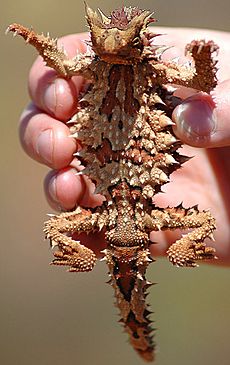Thorny devil facts for kids
Quick facts for kids Thorny devil |
|
|---|---|
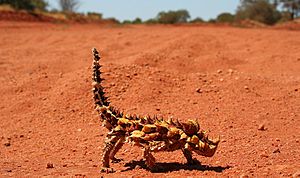 |
|
| Conservation status | |
| Scientific classification | |
| Genus: |
Moloch
|
| Species: |
horridus
|
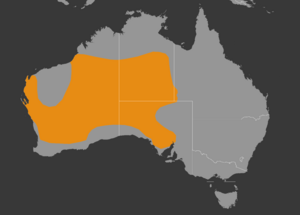 |
|
| Distribution of Moloch horridus | |
| Synonyms | |
|
Acanthosaura gibbosus |
|
The thorny devil (Moloch horridus) is a super unique lizard found only in Australia. It's also known by other cool names like the mountain devil, thorny lizard, and thorny dragon. This amazing creature is the only species in its group, called Moloch.
Thorny devils can grow up to about 21 centimeters (8 inches) long, including their tail. Female thorny devils are usually a bit bigger than the males. They are famous for being covered in sharp, cone-shaped spikes all over their body.
Contents
About the Thorny Devil
The thorny devil was first described by a scientist named John Edward Gray in 1841. It's the only species in its group, Moloch. Scientists think there might be other similar species out there waiting to be discovered.
Even though the thorny devil looks a lot like the horned lizards from North America, they are not closely related. This is an example of something called convergent evolution. It means different animals can develop similar features because they live in similar environments or face similar challenges.
The names given to this lizard, like "thorny devil" or "thorny dragon," come from its scary appearance. The name "Moloch" comes from an old god from the ancient Near East, who was often shown as a scary beast. People also call it the "devil lizard" or "thorny toad."
What Does a Thorny Devil Look Like?
Thorny devils can live for 15 to 20 years. They grow up to about 21 centimeters (8 inches) long. Female thorny devils are usually larger than the males.
Most thorny devils are colored in shades of brown and tan. These colors help them blend in perfectly with the desert around them. Their colors can even change! They become lighter when it's warm and darker when it's cold.
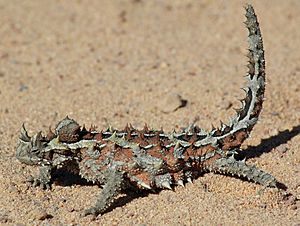
The thorny devil is covered in many intimidating spikes. These spikes are not just for show; they help protect the lizard from animals that might try to eat it. They also use camouflage to hide from predators. When they move, they often freeze and rock slowly. This makes them even harder to spot in the desert.
This lizard also has a spiky "false head" on the back of its neck. When a thorny devil feels threatened, it dips its real head down. Then, it shows off this "false head" to scare away predators. The "false head" is made of soft tissue.
How Thorny Devils Collect Water
One of the most amazing things about the thorny devil is how it collects water. Its skin is covered with tiny ridges. These ridges allow the lizard to collect water just by touching it with any part of its body, like its legs. Water then travels to its mouth through tiny channels in its skin. This process is called capillary action.
Thorny devils can even collect moisture from the air! In the desert, the nights get very cold. When the sun comes up, dew (tiny water droplets) forms on their skin. Their special skin, which is "hydrophilic" (meaning it loves water), has tiny structures that pull in this moisture.
- The lizard might rub its body against damp sand. Its outer skin layer is designed to draw in moisture.
- The skin has tiny hexagonal patterns on its scales. When a little water touches these patterns, they fill up. This makes the skin super good at absorbing water.
- The water then travels through tiny channels under its scales. These channels spread all over the lizard's body. They all lead to the lizard's mouth. When there's a lot of water, like in puddles, you can see the lizard moving its jaw to drink.
Other lizards, like the Texas horned lizard, also have this amazing way of collecting water from their skin.
Where Do Thorny Devils Live?
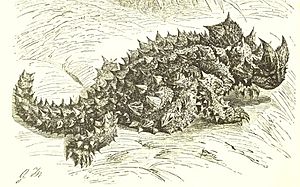
The thorny devil usually lives in the dry scrubland and desert areas that cover most of central Australia. They prefer places with sandy soil, like sandplains and sandridge deserts.
Their habitat in Western Australia is more about the type of sandy soil than the exact climate.
How Do Thorny Devils Protect Themselves?
The thorny devil is covered in hard, sharp spines. These spines make it very difficult for predators to swallow them. It also has a "false head" on its back.
When a thorny devil feels danger, it lowers its real head between its front legs. Then, it shows off its false head to trick other animals. Some animals that try to eat thorny devils include wild birds and goannas.
What Do Thorny Devils Eat?
Thorny devils mainly eat ants. They especially like ants from certain groups like Ochetellus flavipes and others from the Camponotus, Iridomyrmex, and Pheidole families. Thorny devils can eat thousands of ants in just one day!
They also get their water from the desert dew. This dew forms on their skin in the early morning as the sun warms up. The dew then flows to their mouth using gravity and capillary action through the channels between their spines. When it rains, capillary action helps them absorb water from all over their body. They can even absorb water from damp sand, which is their main way of getting water.
Reproduction
Female thorny devils lay their eggs between September and December. They usually lay a clutch of three to ten eggs. The mother digs a nesting burrow about 30 centimeters (12 inches) deep underground. The eggs will hatch after about three to four months.
See also
 In Spanish: Diablo espinoso para niños
In Spanish: Diablo espinoso para niños



